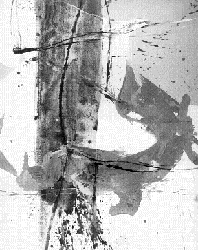
And Deeper It Falls: Acrylic by
Marguerite Saegesser
For Marguerite Saegesser,
abstraction is a form of memory
By Ann Elliott Sherman
Every now and then, while tracking the trends and politics of what art gets seen when and where, there comes a show that seems to exist by the sheer force of quality and truthfulness winning out. Memories and Dreams, the de Saisset Museum's exhibition of recent paintings by Marguerite Saegesser, is such a show.
Although thoroughly contemporary, the art doesn't fit within the current ascendancy of figurative works on curatorial hit parades. Most important is the unavoidable sense that the artist would no doubt have been doing this work regardless of whatever recognition it may bring or cost her.
It's like stumbling across a sudden bubbling up of a clear, fresh spring that has been steadily flowing, finding its way from hidden sources to the surface. The water finds its path via natural forces, its own natural properties, taking on the flavors of the journey while staying uncommonly pure, essential, elemental. A long drink makes you realize how thirsty you were.
Saegesser paints abstracts that work on the psyche like hypnotic suggestion. Going way beyond mere exploration of form or material, she creates the kind of pictures she does not out of any theoretical stance but because abstraction seems best suited to the visual translation of an ongoing, internal dialogue.
Growing up in Switzerland, Saegesser initially trained as a violinist, but slowly left musical performance for sculpture. "I had the feeling I couldn't do music so well as a professional," she recalls. "I was a figurative sculptor when I started, but even then I became abstract in my work. You have to ignore trends, otherwise you lose yourself and try to satisfy opinion that comes from the outside."
Her musical background makes itself felt often in the dynamics of her painting. In La Grande Valse, tonalities of white swathe broad areas of the ground, providing a kind of bass line; roundelays of violet, blue, black and gold crest and ebb across a long, horizontal canvas; thin black lines cross on top of the overall flow.
Ferocious Ghost fairly explodes in a trajectory across three narrow canvases pushed close together, the cracks between them incorporated and emphasized with a charcoal line, reaching a crescendo of violently stroked, saturated blues.
"I used to have a piano; now I have a keyboard," Saegesser explains. "Sometimes, I use it like a crutch, to say whatever comes to mind. It goes faster than painting, so I can grab a mood or situation to develop further in painting. It suits what I'm doing now. Music is a complementary addition, like the titles [that come from journal entries]. My art is integrated. Sometimes I write, sometimes I make music or do painting or printing."
Saegesser doesn't have to strain toward accessibility. Her paintings are moving precisely because they mediate the space between searching and knowing, while avoiding the trap of setting out to "be about" anything. Yet there isn't the shut-off, hermetic removal that alienates so many viewers from abstract painting. Much as a piece of music can trigger individual associations, Saegesser's work is open to discovery.
This is especially true of the series of seven paintings titled Memories. Executed mostly in muted shades of sauterne, straw, gray and sea green, the paintings have an overall hazy wash of filmy white. Calligraphic black marks provide the barest indications of shape, pattern or outline, tracing the suggestion of a horizon here, a peak or graveyard there.
The effect is layered, with some parts nearly blanked out, in an apt mimesis of memory. The reflex to decipher clues of color, shape or line in these abstracted scenes and the sequential ordering of the series invites imposition of a narrative, but the viewer is drawn in, rather than kept at bay, by the enigmatic quality of the works.
But these pieces are more than the brushed and rollered equivalents of familiar cinematic cues for flashbacks. Throughout the show, I was struck by Saegesser's affinity for using shades of white to great, subtle effect, creating emphasis or distance by simply altering the background from pure white to an eggshell tint.
With Memories, she has achieved a kind of translucent radiance. The works translate as much as anything else as a reconstruction of a quality of light once taken in as one does air without thought until it's too late. A movement from the bold colors and broad gestures of Saegesser's earlier work to a more meditative, lyrical style in softer pastel shades is noteworthy, explained by the artist as the result of coming to a greater self-acceptance.
"My interest in Jungian psychology," she tells me, "didn't change my painting in that I didn't start doing mandalas and such. But it helped me find myself more, to be more secure about different sides of myself. Art is such a man's world, that as a sculptor and painter, I felt I needed to be forceful. But I found through my softer side I could express myself freely, not in competition with male artists."
She laughs and adds, "I might go back to the bold colors; who knows?" As one of her titles suggests, for Saegesser, art is always and never the same.
Marguerite Saegesser--Memories and Dreams runs through Dec. 1 at the de Saisset Museum, Santa Clara University. (408/554-4528).
[ Metro | Metroactive Central ]
